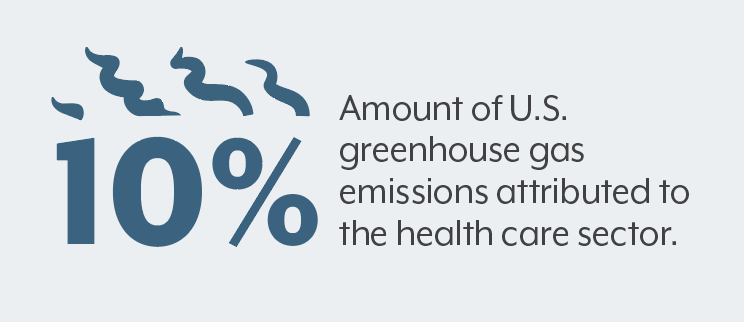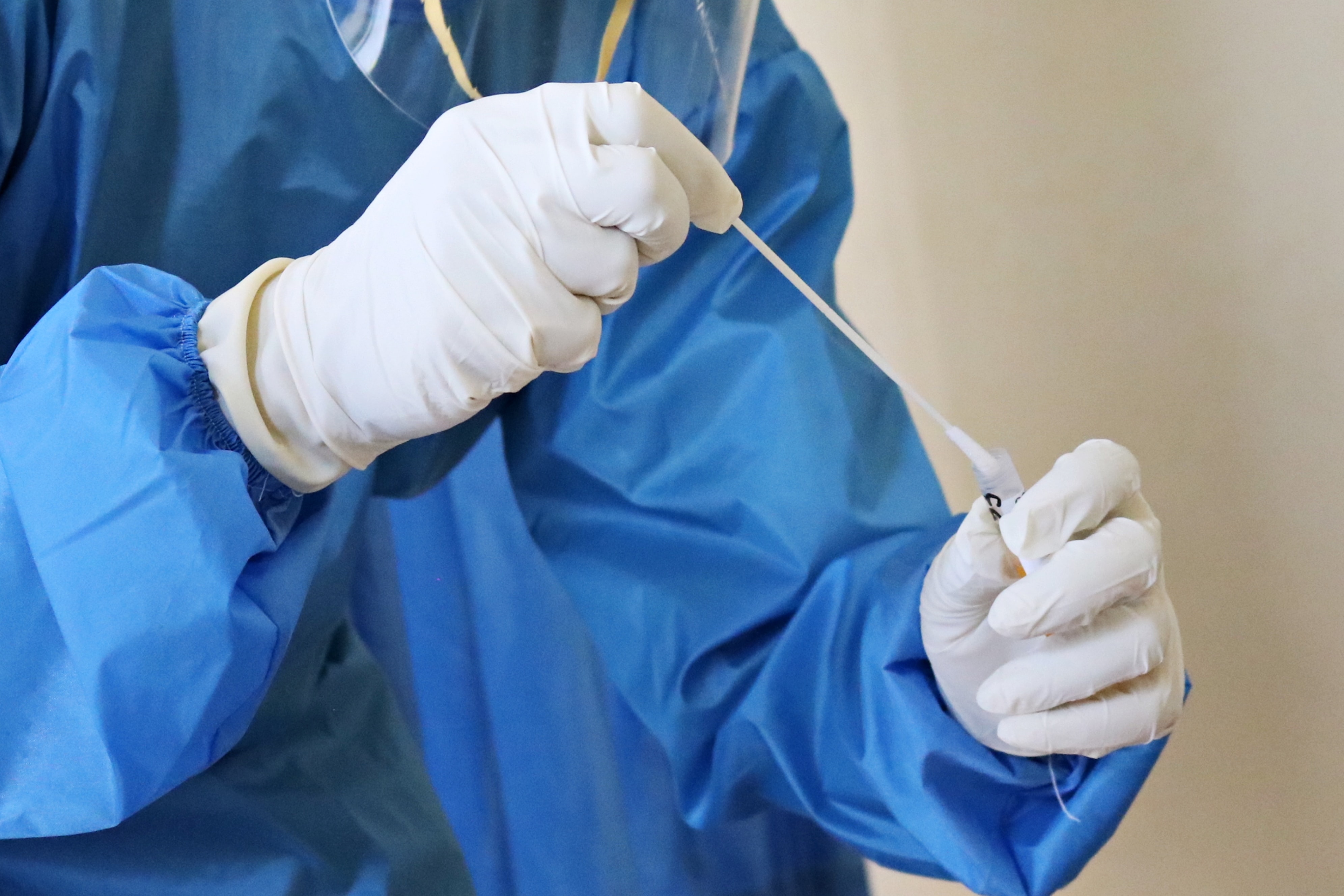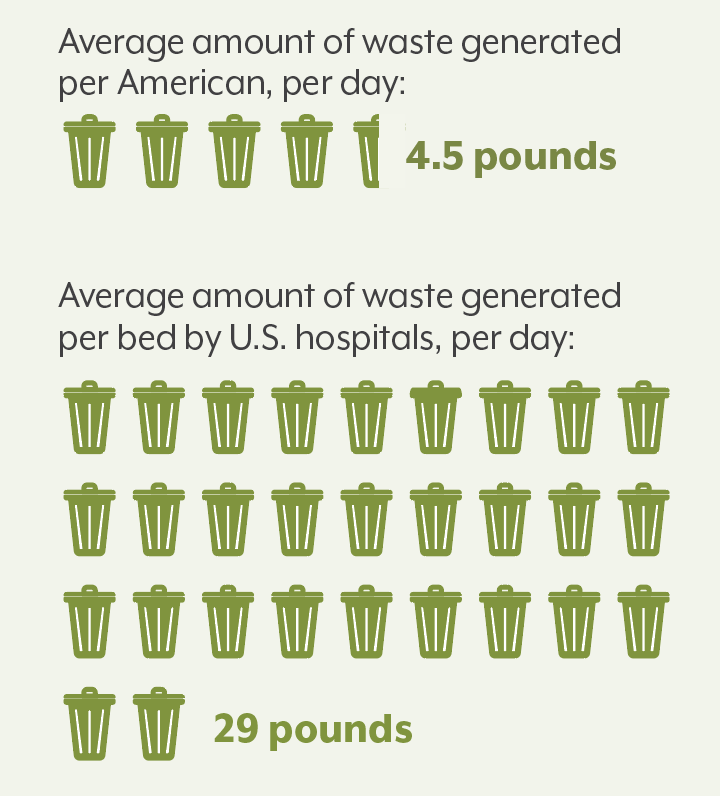
Sustainability in Health Care
Environmental issues have a direct impact on human health, as well as the cost of providing care — two legs of the Triple Aim. So why are hospitals and health systems not yet focusing on environmental sustainability?
The opportunity is too big to ignore. Health spending accounts for 17.7% of the U.S. gross domestic product, so even small changes in health care can have large effects. One estimate shows that air pollution in the U.S. is responsible for 100,000 deaths a year, at a cost of $886 billion to the nation.
The health care industry is responsible for an estimated 10% of greenhouse gases in the United States. These gases and other airborne pollutants from the health sector result in an estimated loss of life on a scale commensurate with deaths from preventable medical errors.
Hospitals have the ability to make change. At the beginning of the 21st century, U.S. hospitals undertook a major effort to save lives by reducing preventable medical errors. Now they have a chance to save lives again by directing efforts toward environmental sustainability.
Hospitals lag many other industries when it comes to mitigating greenhouse gas pollution and cutting waste. That said, leaders have three reasons to “green up” their organizations:
• Increasing profits.
• Decreasing regulatory risks.
• Improving health.
There is an outdated mindset that says it costs more to go green. That’s true only in the short-term. A reliance on disposable products ignores the potential long-term cost savings of sterilizing and reusing equipment. Hospital facilities that don’t have energy-efficient practices use an enormous amount of electricity — over twice as much as a standard office building. That electricity mostly comes from coal and natural gas. It’s costly in terms of dollars and climate pollution. But there is a better way. Consider this: The owners of the 90-year-old Empire State Building undertook an energy efficiency upgrade in 2012. They made their investment back in just over three years and now save $4.4 million annually.
Hospitals put themselves at risk of future regulation if they don’t address sustainability. Roughly two-thirds of Americans favor tighter regulation to address greenhouse gas pollution. Mandates to cut greenhouse pollution — either at the state or federal level — are increasingly possible. Colorado legislators are closely scrutinizing hospital cost structures and community benefit spending by nonprofit organizations. Hospital leaders could address both issues by changing their inefficient and wasteful systems. Kaiser Permanente already has integrated sustainability into its community benefit programs. Hospitals that do the same would be able to make a high-profile demonstration of their stewardship of community benefit dollars.
Finally, hospitals are in the business of improving health, which is tightly linked to the environment. The way we think about health is shifting away from acute care toward a preventive approach in everyday life. Hospitals can contribute and lead in this area by taking responsibility for their own pollution and waste.
The following pages provide ideas on where to start, with a special focus on greenhouse gas emissions and materials waste. They include data about the state of sustainability in hospitals, examples of companies inside and outside health care doing it right, and a discussion of opportunities for health care leaders to go green.

Emissions in Health Care: A Closer Look
There is no reliable measure of greenhouse gas emissions by individual health facilities in Colorado. Accounting for and taking steps to reduce these emissions is an important first step toward addressing a major source of greenhouse gas pollution.
Hospitals are the second-most intensive commercial user of energy, behind food sales and service industries (like restaurants and supermarkets).
Hospitals run around the clock, constantly using heating, cooling, lighting, ventilation, computer, and medical equipment. The environmental and economic costs are steep — U.S. health care facilities spend $8.8 billion per year on energy. And it’s estimated that reducing energy consumption across U.S. health care systems by 30% in the next decade could save lives and over $1 billion in medical costs.
Opportunities to Cut Greenhouse Emissions
Save Energy, Save Money: Retrofitting for energy efficiency can save hospitals up to a third of their energy costs.
Measure: Carbon footprint calculators built specifically for hospitals would allow health care leaders and the workforce to better understand how daily activities — using electricity, waste disposal, etc. — can result in greenhouse gas emissions and promote sustainability as a long-term value. Practice Greenhealth offers toolkits for where hospitals can get started, including a focus on the operating room.
Set Goals: Once hospitals understand their energy use, they can aim for a target reduction and procure more energy from renewable sources. Hospitals can explore incentives from utility companies and governments for undertaking green energy efforts.
Upgrade and Install: The American Society for Healthcare Engineering recommends programming heating and cooling to ramp up only when spaces are occupied, insulating hot water system equipment and piping, and installing on-site renewable energy such as solar power.

Exploring Health Care’s Carbon Footprint
Doing It Right: Kaiser Permanente has adopted a set of environmental goals to meet by 2025 that recognize that climate change is an urgent health issue. Kaiser Permanente also employs a Chief Environmental Officer — a position you won’t find in many C-suites.
$3,000,000: Annual savings realized by Gundersen Health System in Wisconsin after installing energy-efficient equipment and renewable energy sources.
COLORADO SPOTLIGHT
- Leadership in Energy and Environmental Design (LEED) certification is the most common green building standard. Colorado had nearly 3,700 buildings on the LEED list as of August 2020, but only 13 were hospitals or facilities owned by hospitals. They include Boulder Community Foothills Hospital and Medical Center of the Rockies in Loveland. But most hospitals have not undertaken state-of-the-art environmental renovations that could transform them into green buildings.
-
Children’s Hospital Colorado constantly evaluates heating, ventilation, and air conditioning (HVAC), mechanical, and lighting systems to make them more efficient. Their team is exploring installing a new HVAC system that could identify when an operating room is to be occupied and reduce energy use when the room is empty, with the potential for significant cost savings
-
In 2006, Boulder Community Foothills Hospital partnered with Namaste Solar to install a rooftop solar system. It was the first U.S. hospital to install such a system.

Waste in Health Care: A Closer Look
Gloves. Masks. Plastic instruments. Many objects that hospitals buy will eventually become waste. One study found that hospitals produce 7,000 tons of waste each day, and that the health care industry spends $10 billion on waste disposal each year. Reducing waste will require leadership and attention from hospital administrators and clinicians.
At first glance, disposable products seem cheaper. But behind the purchase price are the environmental costs of production, transportation, distribution, and waste management. And often, products aren’t even used before they go into the trash. It is common for disposable items, like isolation gowns, to be packaged in packs – and unused gowns in an opened pack are no longer sterile and are thrown away. Wasted materials are wasted money.
Surgical departments produce over 30% of total hospital waste and two-thirds of regulated medical waste, or “red bag” waste. Single-use, disposable medical devices and products are a big driver. The operating room is a good place for hospitals to start their waste-reduction efforts.
Opportunities to Reduce Waste
Beyond Recycling: The global New Plastics Economy, an initiative from the Ellen MacArthur Foundation, advocates for a full circular economy for plastic. This model consists of three components: eliminating plastic items that are unnecessary; finding innovative methods to ensure needed plastics are recyclable, or compostable; and reusing plastics to keep them in the economy and out of the landfill. The beverage brewing company Ambev aims to cut out plastics and make 100% of its packaging from recycled or returnable materials by 2025.
Rethink Reuse: Hospitals can save money and reduce waste by changing from disposable to reusable equipment. Ronald Reagan UCLA Medical Center saved $1 million over three years — and prevented nearly 300 tons of waste — through a small pilot project to reuse disposable gowns.
Reprocess Disposables: Hospitals can reprocess “single-use” disposable devices like laparoscopic instruments and pulse oximeters, often using outside vendors to collect, sterilize, and return the devices. Reprocessed devices often cost less than half the price of a new device. UCHealth has saved more than $1.7 million by reprocessing single-use devices across several facilities in 2018, and up to $3.9 million in 2019. This practice also keeps single-use devices out of the red bag waste stream, saving money in waste management.
Identify the Impact: Many resources exist to help hospitals understand their waste and its impacts, like the Mazzetti WasteCare calculator and Practice Greenhealth’s Less Waste guide.
COVID-19 Increases Acceptance of Reusable Supplies
The COVID-19 pandemic has brought new awareness about the use and disposal of personal protective equipment, or PPE, including N95 masks, gloves, and gowns. As the pandemic accelerated, many health care providers had difficulty procuring PPE, and some asked staff to reuse their PPE multiple times.
Reusing PPE requires considerable changes in existing processes to ensure sterility, but many companies are innovating in this area. Children’s Hospital Colorado is using a Bioquell decontamination machine to sterilize the surface of items with hydrogen peroxide. Ohio-based nonprofit Battelle has developed a promising decontamination machine for up to 80,000 N95 masks per day. And researchers at the Massachusetts Institute of Technology (MIT) and Brigham and Women’s Hospital are developing a new silicone N95 mask that could be successfully sterilized and reused.
These strategies could help Colorado facilities address PPE shortages in the short term while bringing the long-lasting benefit of cutting hospital waste.

Reducing Waste
$11 Million Per Year: Projected average savings per hospital by managing their supply chains better.
A 2017 Study Showed… 95% of physicians favor reducing waste and 66% prefer reusable surgical tools over disposables. But only 20% like the reusable tools available.
COLORADO SPOTLIGHT
- Littleton Adventist Hospital has cut its waste by 36%, or more than 1,000 tons per year, through sustainable practices such as through recycling, composting, reprocessing, and reusing materials.
- Both Children’s Hospital Colorado and UCHealth have a staff member dedicated to sustainability. Both health systems track their waste and recycling volumes and set annual goals. But a team of one is small at large organizations like these. Sustainability staff rely on help from other employees to implement sustainable practices across operations, procurement, food services, human resources, and waste management.

Next Steps
The value and practice of sustainability should come from the top of an organization to be effective. If initiatives to improve sustainability are to succeed, then hospital leadership should clearly communicate the importance of environmentally friendly practices to their employees and the communities they serve. This often starts with awareness, education, and incentives for employees.
An internal network of allies — a “green team” made up of staff from medical care, procurement, and the physical plant — can be a powerful force for identifying challenges and opportunities for improving sustainability.
Using data and putting a dollar amount on the value of sustainable practices are crucial for success. Hospitals can measure both waste and emissions and set realistic but potentially impactful targets that take into account cost and environmental consequences. Quantifying the effects of these practices can help make the case for adopting them.
More research is needed to understand the current state of sustainability efforts across Colorado’s health care systems. There is an opportunity to bring local stakeholders together to consider data availability and gaps, policy implications, and other opportunities for hospitals to advance in this field.
Opportunities to Promote Collaboration
Practice Greenhealth is a membership organization for environmentally-minded health care providers. Along with its sister research organization, Health Care Without Harm, Practice Greenhealth is a clearinghouse for sustainability and climate health information. Its sustainability specialists also serve as an extension of a hospital’s “green team.”
The organization is facilitating climate alliances in states across the country. There could be an opportunity for Colorado hospitals to engage with Practice Greenhealth or a similar organization to create a forum for conversations about how to advance sustainability in the state’s health care sector.
Sustainability and Inevitability
BlackRock, the world’s largest investment manager, adopted sustainability as a core goal in 2020. This is a signal of where corporate America is going and where much of the rest of the world already has gone, according to Daniel Yohannes, a Colorado business leader who served as U.S. Ambassador to the Organisation for Economic Co-operation and Development (OECD) from 2014 to 2017 and sits on the boards of Xcel Energy and Dow.
“Many companies have begun to provide information on sustainability and program governance in addition to financial reports. If it’s not there today, it will be there tomorrow,” Yohannes said.
He believes the two biggest opportunities for health care systems are building or retrofitting energy-efficient facilities and reducing disposable products and supplies. If done correctly, hospitals could save money by acting in a sustainable manner.

Lessons from the Retail Sector
Sustainability is not a focus in health care. Other industries, however, have made considerable progress toward creating truly sustainable supply chains and integrating sustainability into their business models. One such company is VF Corporation, the parent company of several leading outdoor and activity-based retail brands (including The North Face, Timberland, and Smartwool), with headquarters in Denver. With its commitment to betterment of “people and the planet”, VF is consistently ranked by leading third-party organizations as one of the nation’s most sustainable companies.
A pillar of VF’s sustainability strategy is circular business models, designing products with the end of life in mind. The company has aligned its environmental and social targets with the United Nations’ Sustainable Development Goals. For example, VF has committed to powering 100% of its direct operations with renewable energy by 2025. VF also recently announced science-based targets to reduce greenhouse gas emissions across its entire value chain.
Sustainability isn’t just a practice for VF; it is central to the company’s identity, shared Jeannie Renné-Malone, Vice President of Global Sustainability. That is increasingly important to consumers.
“We look at consumer trends. We are seeing growing interest from the ‘conscious consumer’ who cares about where products originate, who makes them, and how they are made,” Renné-Malone said.
VF’s research shows that more than half of millennials and post-millennials have changed their purchasing habits due to climate change, she said. In the next decade, these groups will account for two-thirds of apparel and footwear purchasing in the U.S.
Renné-Malone said the health care industry has ample opportunities to become more sustainable:
- Hospitals and health systems could quantify greenhouse gas impacts and set targets for reductions.
- Energy efficiency upgrades have an obvious return on investment (ROI) that can be calculated. Energy-saving equipment and technologies can result in increased operational efficiency and associated cost savings over time.
- Hospitals can go beyond seeking LEED certification — which focuses on the environmental performance of a building — and aim to meet standards like Fitwel and WELL, which focus on the health and well-being of the people inside a building. Research shows that companies with a focus on employee health and wellness see increased productivity and reduced absenteeism, therefore creating a positive ROI for sustainable building design.
- Leaders should ask how their facilities can reuse or keep medical products and devices in use to divert waste from the landfill.
Finally, there’s an opportunity to educate people about sustainability when they visit hospitals. “When people visit one of our retail stores, we want them to leave with a jacket but also maybe a new perspective on sustainability,” she said. “I recommend hospital teams look around for open spaces on walls or in entryways, or even near light switches, recycling centers, and water bottle refilling stations, where sustainability stories could be shared with the public and internal teams alike. Once you start looking around, there are ample opportunities to both educate and inform.”

Conclusion
First, do no harm.
This Hippocratic ideal might be unattainable — treatments have side effects, after all — but it remains a powerful aspiration for those called to the practice of medicine.
Most U.S. hospitals are doing harm, unintentionally, through their unsustainable practices. It is time for health systems to begin to moderate their environmental impacts. Reducing waste and greenhouse gas pollution will save lives now and in the future — and even save a little money.




